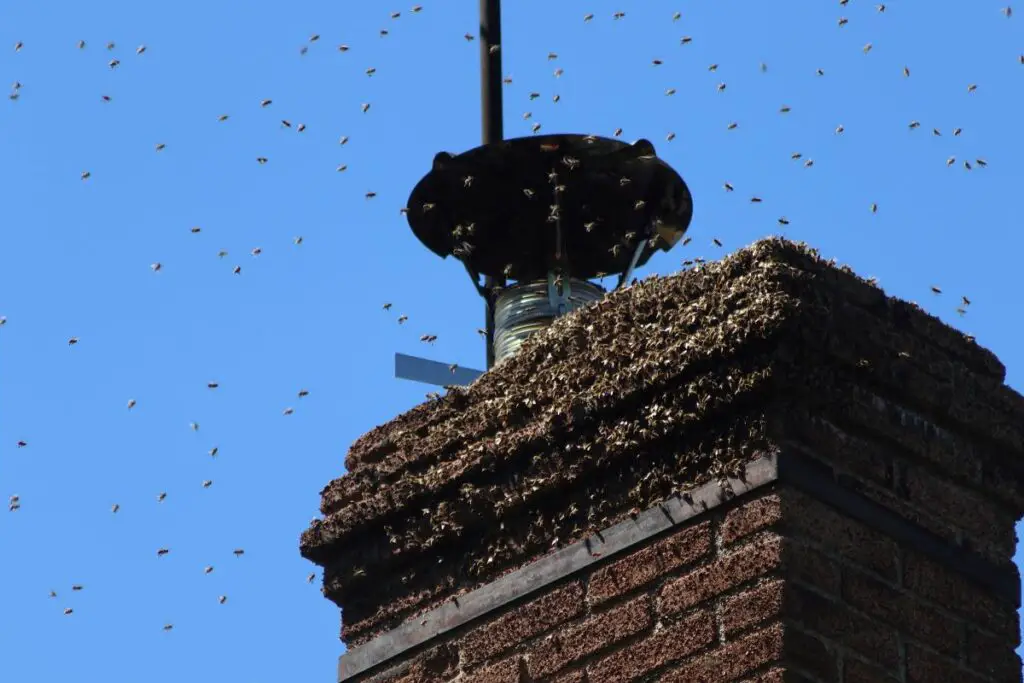Bees in a chimney can be anything from a minor nuisance to a life-threatening risk if you or your family are allergic.
Honey bees swarm in early spring through to summer. They leave their current hive in search of a new home.
This is the perfect guide if they’ve taken shelter in your chimney or flute. We’ll cover what you need to know and what you can do to remove them safely without harming any bees.
What Should You Do If You Have Bees In Your Chimney?
We must take action before we learn more about the effects of bees nesting in your home.
Your first goal is removing the bees, and this should always be left up to professionals.
You need to contact a bee removal specialist who can safely remove the bees without harming them.
The combination of stinging insects and heights can lead to some risky situations, and without the right equipment and skills, you could easily harm yourself.
Your main task should be blocking any potential entry routes into your home, like fireplaces and vents.
Once a swarm of bees calls your chimney home, the queen will begin to lay eggs, and the nest will expand, so reacting quickly is key.
*Safety tip – Never light a fire to eliminate bees in your chimney. If the nest catches alight, it could lead to a full-blown house fire. I strongly advise blocking off your fireplace until you can remove the bees in the chimney.
How Do They Remove The Bees?
The work required will depend on where the nest of bees is.
Bees in chimney stacks can often be removed relatively easily, but nests further in the flue pose a bit more of a challenge.
Removing bees can sometimes require removing some bricks or parts of the chimney to get to the nest site.
They’ll remove the bees, the honeycomb and any waste left behind.
The colony will usually be given to a local beekeeper who can give them a new home in the form of one of their wooden hives.
What To Do Afterwards
You may need to get your chimney cleaned after removing a nest.
This helps eliminate any remaining comb, wax and honey that could attract pests or other bees to come and check out the sweet smell.
Why Do Bees Nest In Chimneys?
When a honey bee colony swarms, it sends out scout bees to find potential new nest sites.
These scouts search far and wide, looking for a suitable cavity.
They choose chimneys as nesting sites due to their resemblance to hollow trees, their natural habitat.
Chimneys provide a protected, enclosed space with a narrow entrance, mirroring the security of tree cavities.
Moreover, the height of the chimneys keeps the hive safe from ground predators and extreme weather conditions.
Why You Should Never Use Insecticides
It’s critical to find an expert who can help with your bee problem in an ethical way that doesn’t harm the bees.
We’re passionate about bees and firmly believe we should try to avoid harming our pollinating friends.
Dead bees and rotting honeycombs can cause untold damage to your property.
Dying bees can’t tend to the nest, and before you know it, the excess honey can drip down your chimney and saturate your walls.
This can lead to unsightly sticky patches and even attract other pests or another colony of bees.
Preventative Measures
Installing chimney caps and screens is essential to prevent wildlife from making your chimney their home.
These devices act as barriers, keeping animals like birds and small mammals out while allowing smoke to escape. Chimney caps also prevent debris and rain from entering, reducing maintenance needs.
Regular chimney maintenance is critical to a safe and efficient fireplace.
Having your chimney inspected and cleaned at least once a year is advised.
This practice secures it against animal and bee infestations, minimizes the risk of chimney fires, and improves air quality in your home.
Creating a Bee-Friendly Environment Elsewhere
Establishing a bee-friendly garden is a delightful way to support these vital pollinators.
Planting various flowering plants, especially those native to your area, provides bees with nectar and pollen.
Ensure a mix of species that bloom at different times of the year to offer a constant food source.
Local beekeeping associations play a crucial role in supporting bee populations. They often provide resources and education about beekeeping, pollinator-friendly gardening, and the importance of bees in our ecosystem.
Getting involved with these groups can help your understanding and efforts in creating a bee-friendly environment.




